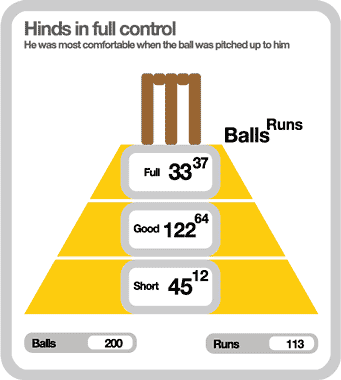Changing gears
S Rajesh
 Wavell Hinds's second Test century was played out in two parts. In the first two sessions, with the pitch quite green and the bowlers relatively fresh, he didn't take too many chances, scoring 67 runs off 155 balls. In the last session, he changed gears, hammering 46 from 45 balls.
Wavell Hinds's second Test century was played out in two parts. In the first two sessions, with the pitch quite green and the bowlers relatively fresh, he didn't take too many chances, scoring 67 runs off 155 balls. In the last session, he changed gears, hammering 46 from 45 balls.
Harbhajan Singh was the bowler who felt the heat of Hinds's onslaught, going for 30 runs from 27 balls after tea. Overall, Hinds clearly favoured Harbhajan, lofting him repeatedly straight down the ground, and then sweeping him with aplomb when Sourav Ganguly kept a long-off. His scoring-rate against Harbhajan was 89 runs every 100 balls; against the rest it was exactly half.
One would expect the good-length ball to be the best way to keep a batsman in check, but with Hinds, the short ball was far more effective. Off 45 short balls, Hinds scored just 12 runs - a strike-rate of just 27%. His strike-rate off good-length deliveries was an impressive 52%.
Harbhajan Singh may have gone for a few runs, but he was India's best wicket-taking option today - as the scalps of Hinds and Ramnaresh Sarwan proved.
Against Harbhajan, the West Indian batsmen were in control of their strokes only 76% of the time - that is, once every four balls, the batsmen played-and-missed, edged, or were struck on the pad when facing Harbhajan. The most innocuous was Javagal Srinath, inducing a not-in-control factor of only 16%. That's a damning indictment of India's leading strike bowler in conditions which were supposed to favour seamers.
India's tour of West Indies - The
complete coverage
Feedback